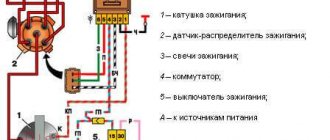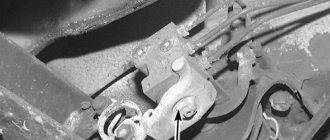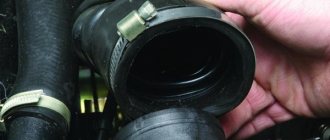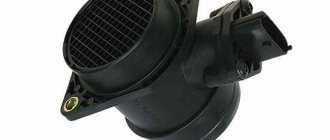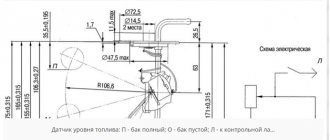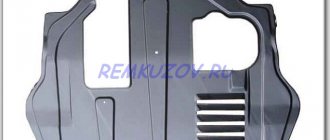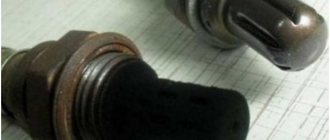Even the most ancient injection gasoline engine is stuffed to capacity with sensors and electronic systems. Failure of any element inevitably affects the operation of the entire engine. The VAZ-2110 received an engine inherited from the eight, it was modernized several times, but the engine control system did not change either on the eight-valve or on the 16-valve car, with minor exceptions. Today we will use the mass air flow sensor as one of the main ones in the power system.
What is a DMRV?
Air flow meter location.
The air flow meter of the VAZ-2110-2112 (as well as all Togliatti injection engines without exception) is installed immediately behind the air filter at the entrance to the intake tract.
Its task is to measure the amount and temperature of the air that the engine consumes.
These readings are of paramount importance for preparing a flammable mixture . The flow meter sends data to the engine ECU, which in turn instructs the injectors to prepare a richer or leaner mixture. This is without subtleties.
Sensor device
The sensor itself is a combination of two sensors - control and working, as well as a heating resistor.
View of the flow meter from the grid side.
The sensor is disassembled.
The platinum thread is visible in this photo.
As a result, air flow and temperature are converted into electrical impulses understandable to the ECU. This is a very gentle and accurate device; it allows you to calculate the cyclic filling of the cylinders with air and updates the parameters every 0.1 s.
Mass air flow sensor diagram.
The working body of the sensor is a heated platinum thread. It heats up to operating temperature (from 100 to 1000 degrees), and when air enters, it cools down. The amount by which the filament temperature drops is converted into an electrical signal and, based on this value, the ECU calculates the mass and temperature of the air entering the combustion chamber. And based on this data, it prepares the required portion of fuel. In short - yes.
Replacing the mass air flow sensor
First we need to say a few words about the sensor itself. I advise you not to save money and buy Boshevsky from a proven site with reviews. The baker took it to clients' cars a couple of times, there were problems. I take these sensors here. There have never been any problems with them. On VAZ 2110, 2111, 2112 the air flow sensor is installed on a pipe that comes out of the air filter and goes into the intake manifold.
- Loosen the clamp securing the corrugated pipe to the mass air flow sensor.
- Remove the pipe from the sensor and move it to the side.
- Press the sensor power connector lock and remove it. The latch is made in the form of a button.
- Unscrew the two bolts securing the sensor to the air filter housing. The fastening bolts are located diagonally. Ten head bolts.
- After unscrewing the fastening bolts, remove the sensor.
After dismantling the sensor, pay attention to the condition of the sealing rubber. If the rubber band is damaged, it must be replaced.
You can install a working sensor with a damaged rubber band and the replacement will have no effect. The speed will fluctuate due to air leaks.
- Installation of the sensor is carried out in the reverse order.
Conclusion
A breakdown of the air flow sensor can cause serious problems in the operation of the car engine. Therefore, every car owner must monitor the performance and remember the service life of the flow meter. If the first signs of problems appear in the operation of the mass air flow sensor, you can try flushing the device; this usually helps at the early stage of contamination.
- https://remontvazov.com/proverka-i-zamena-dmrv
- https://osensorax.ru/rashod-uroven/dmrv-vaz-2110
- https://carfrance.ru/proveryaem-dmrv-na-vaz-2110-multimetrom-svoimi-rukami/
- https://autocentrum.ru/articles/datchiki/18756-priznaki-neispravnosti-dmrv-vaz-2110-chistka-remont-i-proverka-datchika-massovogo-rashoda-vozduha.html
- https://auto-self.ru/priznaki-neispravnosti-datchika-dmrv-na-vaz-2110-kak-promyt-i-pochistit-svoimi-rukami/
- https://FB.ru/article/422090/chem-chistit-dmrv-sredstva
- https://ladafakt.ru/dmrv-vaz-2110-8-klapanov-inzhektor.html
- https://carfrance.ru/datchik-dmvr-vaz-2112-16-klapanov-priznaki-neispravnosti/
- https://www.syl.ru/article/207347/new_osnovnyie-priznaki-neispravnosti-dmrv-vaz
- https://zen.yandex.ru/media/id/5e26640d73034b00ad7f5751/diagnostika-i-ustranenie-neispravnostei-datchika-massovogo-rashoda-vozduha-dmrv-5e538a96fc020165b28c9691
- https://pol-z.ru/dmrv-na-vaz-2110-kak-proverit-nalichie/
- https://autorn.ru/vaz/2110/457-proverka-dmrv-vaz-2110-2111-2112.html
- https://555-shop.ru/remont/priznaki-neispravnosti-dmrv-vaz-2110.html
Symptoms of a malfunction of the mass air flow sensor on a VAZ-2110
Now about the symptoms of a malfunction of the mass air flow sensor. You need to understand that you can definitely blame the mass air flow sensor only after accurate computer diagnostics of the engine management system. Even the on-board computer can easily make mistakes. However, we will try to identify the breakdown without involving specialists.
Symptoms of a sensor malfunction may coincide with symptoms of other malfunctions :
- Increased or floating idle speed.
- It is impossible to adjust the CO level at idle.
- The engine stalls immediately after starting, the speed is maintained only when the throttle is open.
- Increased fuel consumption.
- The Check Engine light comes on.
- Dips when changing speed, loss of power and dynamics.
The symptoms, as we see, are standard for any malfunction of the power and ignition systems. This means that a more detailed check and verification of the parameters with the nominal ones is necessary.
Check: parameters and compatibility
Sensor for Bosch M 7.9.7 controller – number 0 280 212 116 according to the VAZ catalog.
The difficulty in calculating the parameters and ratings of the sensor lies in the fact that different devices with different ratings were installed at VAZ at different times and on different engines . These ratings were programmed into the electronic control unit and if we install a sensor of a different type (although visually it may be exactly the same), the control system will no longer work correctly. Dozens were equipped with sensors from GM, Bosch, Siemens , and a domestic sensor from Arzamas or Saratov .
The calibration for each of them is different. Only after 2004 did VAZ decide on the type of sensor and its ratings - this is a Bosch device of the HFM5 type in three modifications:
- the first was the mass air flow sensor HFM5-4.7 , according to the Bosch catalog its number is 0 280 212 004, and according to the VAZ catalog it is 21083-1130010-01;
- HFM5-4.7 with article number 0 280 212 037 (21083-1130010-10 according to the VAZ catalogue);
- HFM5-CL , catalog number 0 280 212 116 or 21083-1130003-20 according to the VAZ book.
Peculiarities
We conclude that the sensor is selected not by the number of valves or engine size, but solely by the firmware version and ECU model.
Bosch sensor (21083-1130010-01) for controller January version 5.1.
For example, for the Bosch M7.9.7 ECU it is necessary to use the Bosch mass air flow sensor 0 280 212 116, and for the January controller version 5.1 - only Bosch 21083-1130010-01. That is, even if a sensor is installed from the factory that does not correspond to the ECU firmware, you cannot expect correct engine operation and normal fuel consumption. By the way, there are often cases when sensors were installed from the factory that do not correspond to the firmware version. Therefore, the first check is for compatibility. And then we take a multimeter and go into battle.
Cleaning instructions
As practice shows, cleaning the mass air flow sensor is one of the most effective methods of restoring the functionality of the controller. Therefore, if the sensor breaks down, it is not necessary to change it, especially since such a pleasure today is not cheap. This procedure is necessary because over time it becomes dirty and shows other parameters.
So, how to clean the mass air flow sensor at home with your own hands:
- You will need a Phillips head screwdriver; use it to loosen the clamp securing the line from the air intake.
- Next, dismantle the corrugation and visually assess the condition of the system. You may see condensation or traces of engine fluid under the corrugation.
- Carefully inspect the inside of the controller. If everything is normal with the system, then there will be no traces of leaks or contamination. As practice shows, the sensitive element often breaks precisely due to an excess of contamination. In order not to avoid problems of this kind in the future, it is necessary to periodically replace the air filter. This procedure is carried out in accordance with technical regulations. Engine fluid may enter the controller as a result of an increased level of consumables in the crankcase. Accordingly, this occurs as a result of a clogged oil separator in the ventilation system.
- The regulator itself is fixed with two bolts on the line. The removal procedure is carried out using an open-end wrench. At this stage, if you are sure that the device has failed, you can replace it.
- You can see the entrance on which there will be a sealing rubber band designed to protect the device from the suction of dirty air flow. If you do not have a seal, it may have caught on the filter element. Accordingly, this will lead to the regulator input grid being contaminated.
- Clean the mesh using available materials. To do this, you can use a regular toothpick or toothbrush. After cleaning, the seal can be put back and the regulator can be put back in place.
We check the mass air flow sensor on a VAZ-2110 with a multimeter
The sensor block, the first wire may not be there - this is normal.
To do this, we need to understand the pinout and the sensor connection diagram. As you can see, the block has only five wires:
- + 12 Volt.
- + 5 Volts.
- Total ground (green wire).
- Air temperature output signal.
- Air flow signal output (yellow wire).
Electrical diagram for connecting the mass air flow sensor.
The pinout may differ in different firmware versions and on different sensors. Everything is clear with the first two contacts - take a multimeter and check the presence of voltage when the ignition is on. If there is no signal, we look for the cause either in broken wires or in poor contact. Now we check the main indicator - the accuracy and magnitude of the air flow signal. By the way, this can be checked without a multimeter, using the on-board computer, if one is installed:
- We go to the menu, look for sensor parameters.
- Find the voltage Udmrv.
- The rating for all of the above modifications is from 0.996 to 1.01 V.
The platinum thread gets tired over time and distorts the impulse upward. A change of even one hundredth of a Volt is unacceptable. If the computer is not installed, we use a multimeter. We check the voltage between 3 and 5 (minus) contacts , setting the measurement limits on the multimeter to 2 V. Turn on the ignition, but do not start the engine.
The scale shows 1.00 - the sensor is in excellent condition.
On a scale of 1.26 – the sensor is “dead”.
Check table
We evaluate the result using this table:
| 0.99-1.02 V | The condition of the air flow sensor is excellent, close to new |
| 1.02-1.03 V | Sensor in good condition |
| 1.04-1.05 V | The platinum thread is worn out, you need to think about replacing the sensor |
| More than 1.05 V | The sensor does not work, urgent replacement is necessary |
Diagnosis of failure
If the air flow sensor breaks down, the symptoms of the malfunction can be very different. First of all, fuel consumption will increase; another symptom may be floating engine speed.
In addition to these signs of failure, the following can be identified:
- failures in the operation of the power unit;
- slower car acceleration, poor dynamics;
- the power unit can turn off when changing gears;
- decrease in power and increase in gasoline consumption;
- a heated internal combustion engine is more difficult to start;
- the Check light appears on the control panel.
The last symptom may not appear if the controller fails completely. How to check the MAF on your own? Diagnostics consists of identifying the impulse.
If the impulse is low, this indicates:
- possible short circuit or broken wiring;
- regulator failure;
- incorrect operation of the ECU;
- oxidation of contacts;
- that the controller is not connected.
Clogged air flow regulator
Checking the air flow sensor on a VAZ 2114 with a multimeter
And the third way, checking with a multimeter:
- Insert a multimeter into the system to measure the current flow. The mode should be up to 20 watts;
- connect the red cable to the yellow one (pin 5), and the black cable to the green cable (pin 3);
- insert the key into the ignition and turn over, but do not start the car;
- The multimeter will show readings, look at them.
- when starting the car, the speed fluctuates sharply, and when you press the gas pedal, the engine stalls;
- Relieving the gas completely, the speed is held at 2-3 thousand for a couple of seconds.
- the car cannot gain speed due to lack of traction;
- The “check engine” injector lights up on the control panel.
If the engine and the car itself work without interruption, drivers of a VAZ 2114 rarely associate a lit “check” light with the operation of the mass air flow sensor. Therefore, you should not ignore the illuminated “check” indicator and consider it a computer error. If the manifestations described above are identified, then it is necessary to carry out diagnostics. After all, a malfunction of the mass air flow sensor system may be similar to other car breakdowns.
How to decipher multimeter information?
- The multimeter shows from 0.006 to 1.01 V - this means that the sensor is still new. In a few weeks, the data will increase by a couple of hundred units.
- If the multimeter data is in the region of 1.01, 1.02 V, they indicate that the sensor is in use mode, this is its operating state.
- The sensor shows 1.03 - 1.04 V, - such readings will indicate that the working reserve is half used.
- Sensor readings 1.04V -1.05V - such readings indicate that the sensor should be replaced with a new one.
- Sensor readings above 1.05 V sent to the ECU are incorrect. Most likely, it does the work incorrectly, or does not do the work at all.
DMRV pinout
- a pink-black cable is responsible for sending data from the mass air flow sensor device to the relay. Designated as contact No2;
- for grounding, green cable. Designated as contact No3;
- white, responsible for powering the mass air flow sensor device. Defined as pin No4;
- The yellow cable is defined as contact No5 and is responsible for transmitting an impulse from the ECU (electronic control unit).
MAF pinout for VAZ 2114
But it is worth considering that the colors may differ from those described above. Sensor manufacturers may replace the described colors with others. Be careful!
Based on the readings of the device, you can easily determine what exactly the problem is. And don’t waste time identifying the breakdown. Also, based on the readings of the multimeter, you can carry out the necessary work, such as cleaning, checking contacts, or replacing a new device yourself. But it’s also worth considering that the tester can overestimate its readings. This is a risk of replacing a completely working sensor with a new one when it does not need it. The sensor parameters depend on the purity of the masses in the circuit.
Principle of operation
What is a mass air flow sensor and what is its operating principle? Let’s say right away that you cannot confuse the mass air flow sensor with the outside air temperature controller, since these are two completely different devices. The primary purpose of the flow meter is to calculate the required volume of air flow that enters the engine cylinders. This air is one of the components in the formation of the air-fuel mixture. The mass air flow sensor itself in the “Ten” is located behind the air filter element.
In order for the engine to operate in normal mode, when forming a combustible mixture, the ratio of substances must be strictly observed - 1:14. If these proportions are not observed, the engine will not operate correctly, which will ultimately lead to excessive consumption of gasoline or a decrease in the dynamics and power of the vehicle. Thanks to the flow meter, the air flow is transferred to the engine cylinders in certain portions. Data on calculating the volume of air flow entering the engine is sent to the electronic control unit. In accordance with the data received, the ECU calculates the required amount of fuel.
When the driver presses the gas pedal, the volume of supplied air flow increases significantly, and accordingly, this leads to an increase in gasoline consumption. If the vehicle moves evenly, then the portions of fuel and air flow that enter the cylinders will also be the same at each cycle. When you press the gas pedal, the throttle opens, which ultimately leads to an increase in the supplied air, and this also contributes to an increase in the load on the power unit.
Let's sum it up
As you can see, the VAZ 2110 mass air flow sensor is a fairly important component of the car in the ECM device. This sensor closely interacts with the computer and determines the degree of enrichment of the fuel mixture with air.
Finally, we note that if the sensor is dirty, it is not necessary to immediately resort to replacement. At the initial stage, it is cleaned, as well as the pipes are treated to remove accumulated debris, dust and dirt, and at the same time, all components of the sensor are inspected. However, if there is no positive result, it is necessary to purchase and replace the device.
Source
Shutdown
Pulling out the sensor is fairly easy. It is located in the air filter.
This method involves starting the motor with the sensor removed - we need to disconnect its connector. When turned off, the controller starts emergency mode, and new portions of the mixture are calculated based on the position of the damper. We need to drive a little, the speed should be above 1500 rpm. If the car behaves more dynamically without a mass air flow sensor, then the diagnosis is complete - it’s time to change the consumable.
Let's summarize
From the above, we can conclude that you can check the VAZ 2110 mass air flow sensor using a multimeter yourself. By comparing the ADC readings with computer diagnostics, we can say that the test with a multimeter is correct.
It is also worth noting that if you want to maximize the life of the air flow sensor, change the air filter more often. The manufacturer recommends replacement every 30 thousand kilometers. We recommend reducing this interval to 20 thousand kilometers, and if you mainly travel on dusty roads to 15 thousand km. mileage
The process of replacing the MAF VAZ 2110, 2111, 2112 is clearly shown in this video:
Source
Spare part selection
There are sensors on the market in three price categories:
- Inexpensive. Typically these are Chinese-made sensors priced up to 1,200 rubles.
- Average. This category includes sensors from AvtoVAZ and foreign analogues of approximately the same quality. Their price ranges from 1400 to 2600 rudders.
- Expensive. High-quality and reliable mass air flow sensors from manufacturers Bosch or Siemens. Their price can reach 5,000 rubles.
We recommend giving preference to original sensors from AvtoVAZ or foreign analogues in this price category.
Methods for checking sensor functionality
How to check the flow meter yourself? There are several diagnostic options, we suggest you familiarize yourself with each of them (the author of the video is the Bezdelnik TV channel).
Shutdown
First you need to try disconnecting the flow meter from the power supply. To do this, you need to start the engine and let it run for a while. Next, you will need to disconnect the plug from the flow meter - after this, the emergency mode of operation of the motor should be activated. In this case, the volume of required air flow will be calculated in accordance with the throttle position. If, after switching off, you notice that the engine began to work more correctly and at the same time it became more dynamic, then the mass air flow sensor definitely needs to be replaced.
Diagnostics using a multimeter
Diagnostics can be performed using a multimeter; for this we recommend that you read the operating instructions for the tester. The device must be configured in the DC voltage measurement mode; it is usually marked with the symbols DCV or V.
To ensure that connecting the device does not cause difficulties, you need to know exactly the pinout of the device:
- black-red or pink contact is a connection to the control module;
- green is ground (grounding, ground), connected to the body or battery;
- gray-white contact - output voltage;
- yellow - used to supply current to the input.
Diagnostics with a multimeter is performed as follows:
- To begin with, the tester should be turned on and the voltage value set on it to 20 volts, and then the probes from the device are connected to the corresponding contacts on the plug.
- To make the connection more convenient, you can use pins; you will need two of them. Each of them is installed in a hole with green and yellow contacts. Then you will need to connect the probes of the device to these pins.
- The next step is to activate the ignition and measure the voltage. Read more about the test results below (the author of the video is the IZO channel)))LENTA).
On a working device, the voltage level will be around 1.01-1.04. If the readings are between 1.02 and 1.05 volts, this indicates that the device will need to be changed in the near future. If the readings obtained are higher, then the flow meter must be replaced because it is faulty.
It should be noted that during operation, the voltage parameter will only increase, since the resistor components of the device wear out, and the resistance value, accordingly, decreases. You can also accurately determine the voltage using the on-board computer, if it has the appropriate function. To search, go to the flowmeter voltage section and find the U value.
Visual inspection
As for visual diagnostics, first of all it is necessary to check the condition of the corrugation in which the flow meter is installed, as well as the device itself. If, as a result of the check, you see traces of motor fluid or condensation, then it is possible that the device does not work for this reason. In some cases, cleaning the device from contaminants allows the flowmeter to resume operation and prevent possible replacement. It should be taken into account that contaminants usually accumulate as a result of infrequent replacement of the air filter element (the author of the video about the regulator malfunction is the channel In Sandro’s Garage).
If you notice traces of engine fluid, then there is a possibility that the reason lies in a clogged oil seal, or the problem may lie in exceeding the permissible level of lubricant in the crankcase. When cleaning is complete, you will need to make a visual inspection of the regulator - on the front of it you can see the rubber seal that is used for sealing. The seal is necessary to prevent uncleaned air flow and it may be that the rubber band moves a little - this will lead to the accumulation of dust on the flowmeter grid.
Replacement
It is not difficult to replace the mass air flow sensor with your own hands, even if you do not have any special skills in car repair. Having checked the condition of the device and determined that cleaning will not help, all that remains is to replace it.
- Place the car on a level surface, lift the hood and remove the negative terminal from the battery.
- Disconnect the sensor connector. We have already talked about its location, so there will be no problems with the search.
- Using a screwdriver, remove the clamping bolt of the clamp that secures the corrugation to the mass air flow sensor.
- The corrugation is removed.
- Using a 10mm wrench, unscrew the two bolts that hold the sensor to the air filter housing.
- After removing the failed oxygen sensor, install a new regulator in its place.
- Screw back a couple of bolts, secure the corrugation and secure it with a clamp.
- Reconnect the connector and return the negative terminal to the battery.
If everything is done correctly and the breakdown is correctly identified, then the engine will return to its previous performance and the error signal on the dashboard will disappear.
Replacing the device
To finally check the result of the repair, go out onto the road, do a test drive and be sure to try to press the gas pedal sharply. If the dynamics and power become the same as before the problems arose, you did everything correctly, and it was the mass air flow sensor that was the culprit of the malfunction.
Sensor restoration
Before starting work on the car, it is necessary to deactivate the ignition and disconnect the plug with wires from the regulator.
What will you need?
To carry out the procedure you will need:
- rags;
- set of wrenches;
- cleanser;
- a screwdriver if its use requires dismantling the flow meter.
Selecting a cleaner
Products that can be purchased at the store to clean the controller:
- WD-40. A universal product that can also be used for cleaning.
- Liqui Moly. The use of such a composition is relevant for working sensors. The product is universal and can be used on both diesel and gasoline engines.
- Alcohol.
- Cleaning agent for carburetor engines.
- Liquid key. This product is sold as a spray.
- Air Senso Clean.
Good to know
Do not use cotton swabs or compressed air to clean the device.
It is important that the cleaning agent does not contain acetone or ether
| Image | Step |
| The user must remove the hose connected to the sensor; to do this, use a wrench to unscrew the screws securing the device to the air filter housing. The dismantling algorithm may differ depending on the design features of the car. | |
| |
|
